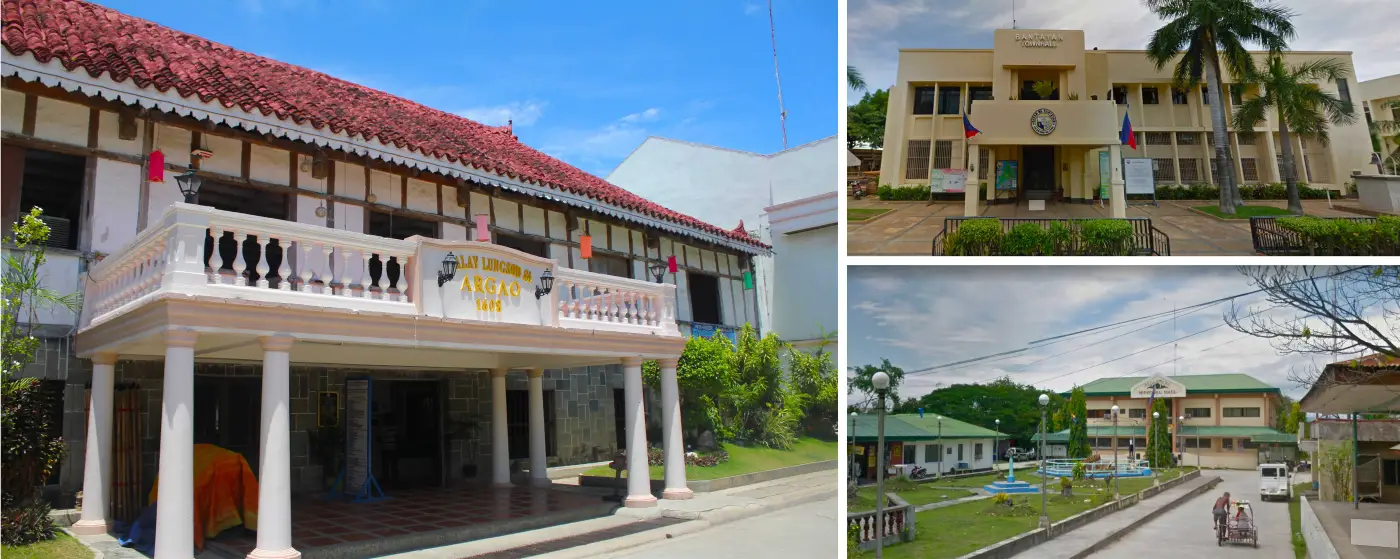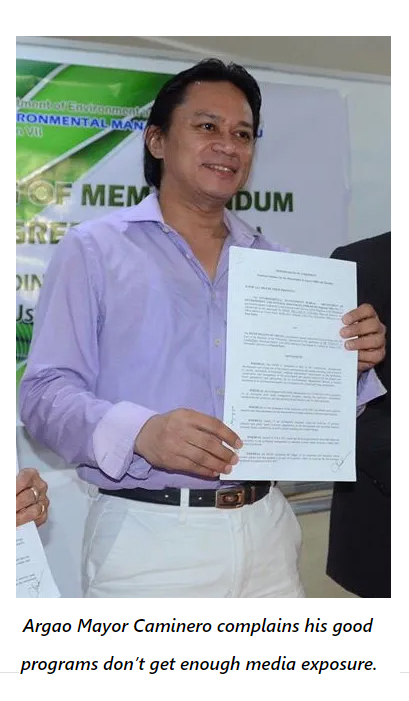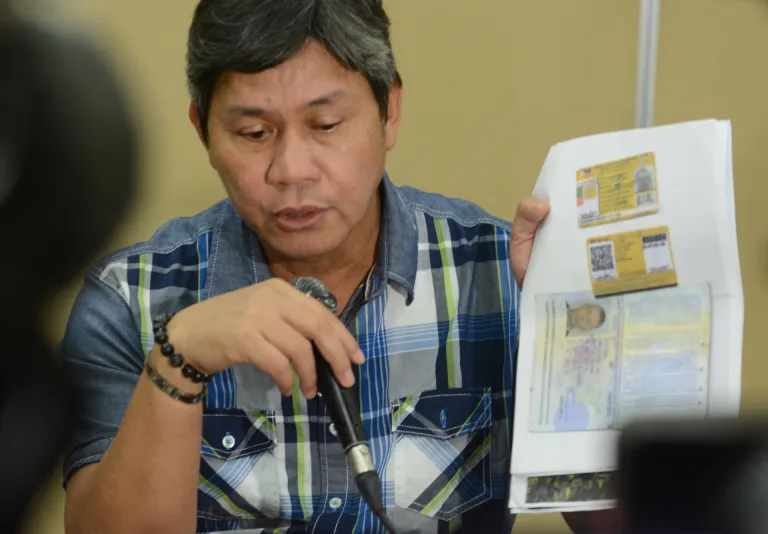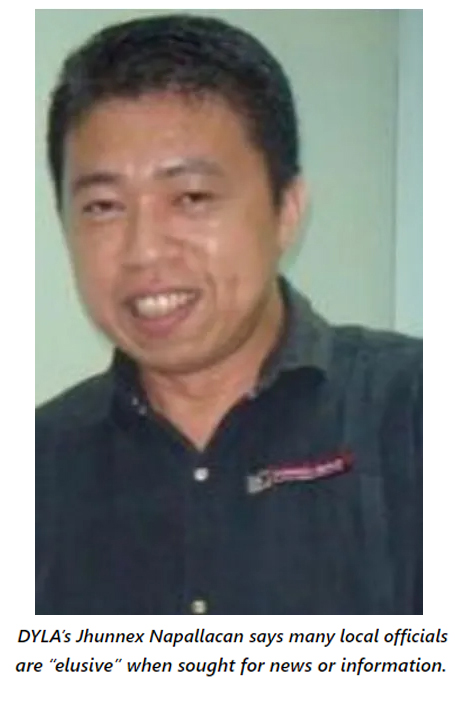Under-coverage of local governments: public officials’ gripes, media’s explanation
Covering local governments

Under-coverage of local governments: public officials’ gripes, media’s explanation
JOVI TAGHOY GERODIAS
Feb. 9, 2019
MAYORS, mostly of LGUs outside Metro Cebu, complain that their projects and programs have not been publicized by mainstream media. “They send out reporters and news crew to us only when the news is sensational or negative.”
IN the southern town of Argao, Cebu locals and tourists alike may be jailed if caught smoking at a public place. The local government has had a working anti-smoking ordinance since 2016.

Argao Mayor Stanley Caminero, however, laments that this “initiative and other well-meaning programs” in his town have not been given enough exposure or coverage by the Cebu media.
“Even Gov. (Hilario) Davide is not exempted sa ‘no smoking’ ordinance. Apan ang akong smoking ordinance wa pud na ma medya,” the mayor, a medical doctor, says.
One time, Caminero recalls, the Argao government had to launch “Dalagang Argawanon” at the Capitol Social Hall in Cebu City to ensure the event would’ve media coverage.
But are local executives as desirous of media coverage when the story in question tends to depict them in less than positive light?
Local executives’ wish
Caminero is among the local chief executives who wish mainstream media would give enough attention to local legislation, initiatives and advocacies for the good of their constituents.
For Caminero, the media is an effective tool for information dissemination.
“There are some good things happening in the countryside, in the LGUs,” he says. Caminero doesn’t know the criteria of media in assessing a newsworthy event. “Must it always be sensational?”
“Wala lang gyud siguro mahasum-ok ang media didto. Maong wa nila ma report basin og nay daghan laing gika-busyhan nga para nila mas sensational siguro. Unya ang kana anaa sa amoa sa Argao kay di man na sensational pero dako siya og ikatampo sa kaayuhan sa katawhan,” he says.
‘Paspas’ if negative
Except for high-profile crimes or tourism developments in his locality, Mayor Jose Esgana of Sta. Fe town in Bantayan Island says local-initiated measures are also not covered by the media.
“In terms of coverage sa medya, ang among lugar as one of the tourist destinations sa Cebu Province, it’s very normal nga naa jud dayon taga medya nga mo-cover from mainland (Cebu City). Ang attention naa sa among municipality, especially during Holy week, mga long weekend,” he narrates.

Sta. Fe Mayor Esgana says about press coverage: “Wa kaayoy media”
“In terms of projects, medyo kulang. Wa kaayo’y miadto didto aron mopahibalo kong unsa. Pero og moingon ta’g coverage og mga negative, paspas kaayo sila.”
Esgana says there are many programs initiated by the local government of Sta. Fe that have not been not reported by the Cebu media.
For example, Esgana says, the local government has been strongly advocating for local tourism and has been working on solid waste and septage management projects.
For him, these initiatives and other local programs should have been covered by the media for public awareness, especially the establishments that operate in the island town.
Accomplishments
Like Caminero and Esgana, Mayor Beatriz Caburnay of Alcantara also hopes the programs and projects, especially on infrastructure in her town, will also be covered and reported by the media.
“Mura’g wala pa jud ang medya nakaabot didto sa among lungsod. Manghinaut pud ko nga maabot sa among lungsod para at least among ma-discuss ang among mga project,” she says.
Caburnay wishes the media will find time to check on accomplishments of the local government of Alcantara, such as construction of farm-to-market roads and improvement in delivery of basic services, including introduction of livelihood programs for fishers and farmers in the town.
She says a drainage project in Barangay Polo aims to solve the flooding problem in the area. The water system project in Barangay Cabadiangan is also in progress, which is expected to benefit nine other neighboring barangays.
For Caburnay, Alcantara is not far from Cebu City, but distance shouldn’t be a reason not to get news outside Metro Cebu.
Social media, PIOs
In the absence of coverage from the mainstream media, local government units are maximizing the use of the social media and hiring a Public Information Officer (PIO) for each town.
They say they now have Facebook pages where they post news and updates on the town’s programs. Their PIOs are tasked to conduct massive information dissemination.
But, Esgana says, the level of exposure when getting featured in the mainstream media is totally different. “Social media is social media, which is open to comments, but wala gyu’y nakaabot sa broadcast,” he says.
Caminero hopes mainstream media will support LGUs in their “good advocacies” as part of the media industry’s “community, social responsibility.”

Un-informed constituency
He says one effect of under-coverage or under-reporting by media is an un-informed or ill-informed constituency. They won’t know what the local government is doing or not doing.
Caminero says that some local government units may even emulate the measures undertaken by other localities. “For instance, ang kanang No Helmet, No Ride sa Dalaguete, wa pa ko kita ana sa newspaper. Pero og na bring-up na siya, moingon ang ubang LGUs nga oy ato nang sundon tinuod kay that’s for the good of our constituents unya mauwaw ta nga ang ubang LGUs naa na, unya, ang atua wala pa.”
Reporting LGU programs and measures will complement efforts of the local government, Caminero says. “Kong ang mga media people would look at things that are contributing much to the improvement of our communities and make it known to the rest of the LGUs, the rest of the province, or maybe the rest of the world… they would look at our current society that there is hope for the future. Otherwise, if people do not know there are LGUs that are initiating these good things. There are leaders who are firm in their leadership, in their administration.”
The Argao mayor says under-coverage by media is, in a way, denying truth from the public. “I believe that media should tell the truth. And there are truths about what’s happening in terms of killing just as there truths about what’s happening in terms of advocacy for well-meaning programs of the LGUs.”
Access by media
What does media have to say? A number of media executives agree with local officials on under-coverage but they also offer suggestions on what LGUs can do. Be more accessible to media, for one.
To the mayors’ complaint of under-coverage, the news editors offer explanations and suggestions. But media is not about to change the protocol of picking only the most noteworthy event to send a news crew to outside Metro Cebu. It’s a question of news value, resources and time and distance. Or so the news executives contend.

Jhunnex Napallacan, station manager of dyLA, says that many local officials are “very elusive.” “I share their sentiment. It’s true that areas outside Metro Cebu are not well-covered but LGUs must also try to be accessible to the media. Ang uban nila mahadlok sa media or way gana sa media. One time, when I contacted a mayor in one southern town, he berated me and demanded proof proof of my being in media,” Napallacan says.
Jhunnex says it is difficult to go to their town or city every day because of the distance and transport cost, so they must see to it they can be contacted.
Napallacan advises local officials to establish good communications or networking with the media, so it can send publicity releases about their projects and programs.
As a policy, Napallacan says, media should not just rely on press releases but editors and managers assess the necessity of sending out a reporter.
Distance, not lack of interest
Roger Vallena, news editor of SunStar Super Balita Cebu, says he also agrees with the local officials, “they must also understand that distance, not the lack of interest, is the main reason most LGUs are not covered by media organizations.”
Hiring an information officer who has the experience in journalism can help them in reaching out to media outlets, Vallena says.
Aida Tampus, news director of RMN dyHP, says an LGU may communicate with the news editor or news desk of a news outfit regarding information it wants to be publicized.
The PIO can email, fax or post on the LGU’s social media wall news or information about the town’s ordinances, announcements and progress reports on its projects and programs.
Tampus, though, points out that the news editor or news desk decides on what material the the LGU’s PIO sends out may be used. Tampus says the “bottom line” is “open communication.”
Impact on circulation, reach
According to the three media executives, under-coverage has not substantially affected their circulation or audience reach.
Napallacan though recognizes that coverage of areas outside Metro Cebu can boost “listenership” because a story or feature about a town encourages the locals to listen to the radio station.
Vallena says that based on his experience (having been in print media for more than two decades), under-coverage or under-reporting has not affected Superbalita.

Superbalita’s Vallena says limited coverage in places outside Cebu City has had little effect on the paper’s circulation.
We used to have a page devoted entirely for municipalities in the province. It did not increase our circulation. Having a news or feature about a town once a month is not enough inducement for town readers to buy your paper daily,” he observes.
Matter of resources
Napallacan says dyLA has been trying its best to give maximum coverage in various localities but because of the limited resources, bigger news stories are always given importance.
“Di man intawon pwede nga moadto og Bogo City aron lang kuhaon ang balita nga wa moagas ang ilang tubig, pwede ra man na tawgon sa telephone. Pero kon may daghang nangasakit na tungod kay wa tubig, simbako lang ha, adtoon na gyod na,” he says, “the media also has to be practical.”
In this era of social media and technology, Napallacan says that some dyLA listeners from different areas feed the radio station with a tip or news alert, which a reporter or anchor person will verify before broadcasting it.
At dyHP, Tampus says, as long as the news is with public interest, relevant and timely, it must be reported.
“Airing of news items depends on the time slot and the length of the news program. The bigger the news, the more it will be given priority to be aired,” Tampus says. 
